ABOUT

IndiaSkis is proud to be associated with the development of Biathlon sport infrastructure & Equipments in India.
Biathlon consists of cross country skiing in which the skier stops at intervals to shoot at a target. Evidence of a skiing and shooting sport exists in cave paintings in Norway from about 2000 BC, depicting hunters on skis while stalking animals for game. The modern sport has a military basis, in which Scandinavian soldiers were trained to ski while carrying rifles and to periodically stop and shoot. Biathlon-type events in Scandinavia are known to have been held as early as the 18th century.
The first modern biathlon probably occurred in 1912 when the Norwegian military organized the Forvarsrennet in Oslo. An annual event, it consisted initially of a 17km cross-country ski race with two-minute penalties for the shooting part of the competition.
Attempts to introduce a winter multi-event patterned after the modern pentathlon began in 1948, when the Winter Pentathlon was contested at the St. Moritz Olympics as a demonstration sport. It consisted of cross country and downhill skiing, and also shooting, fencing, and horse riding. The first world championships in biathlon were held in 1958 at Saalfelden, Austria. The sport was quickly placed on the Olympic programme, appearing in Squaw Valley in 1960. Women's biathlon made its Olympic debut in 1992 as a full medal sport in Albertville.
Biathlon was originally a tactic of survival rather than a sport. Northern Europeans skied to hunt for food and, later, skied with weapons to defend their countries. The word "biathlon" stems from the Greek word for two contests. Today it is interpreted as a joining of two sports: cross-country skiing and rifle shooting.
In 1960, Biathlon joined the International Modern Pentathlon Union (UIPM). But in 1993, an agreement was made to retain the Union as an umbrella body under which the UIPM and the IBU could act autonomously. It took effect in 1998, but the two sports maintain relations in various projects.
COMPETITION
Biathlon consists of ten events in the Olympic programme. Men and women compete in a sprint, pursuit, individual and relay. Although all biathlon disciplines combine skiing and marksmanship, the sport features several distinct events.
Sprint
During the sprint, women race 7.5km and men race 10km. Competitors stop twice and must hit all five targets with five bullets. For each target missed, athletes take a lap around the 150m penalty loop. The top 60 finishers of this competition qualify for the pursuit.
Pursuit
In the pursuit, the competitors start at intervals based on their finishing time in the sprint competition. Women race 10km and men race 12.5km. Competitors stop four times and must hit all five targets with five bullets. For each target missed, athletes take a lap around the 150m penalty loop.
Individual
In the individual event, women race 15km and men race 20km. All competitors stop four times at the firing range and must hit all five targets with five bullets. For each target missed, one minute is added to their total time.
Relay
The relay is a fast-paced team event in which four-person teams tackle four 7.5km legs for a total of 30km. It begins with a mass start by the first skiers of their respective teams. Each team member has two firing sequences and is allowed three extra bullets (a total of eight) to hit five targets, yet must load the three extra bullets one by one. For each target left standing, competitors ski a lap around the 150m penalty loop.
Biathlon Equipments:
1. Arm Sling
Used to stabilise the rifle while shooting.
2.Boots

These are more rigid and have more ankle support than classic technique boots because they are subject to considerable lateral pressure.
3.Clips
Also called a magazine. Used to hold five .22-calibre rifle cartridges. Up to four clips can be stored in the rifle stock while the athlete skis the course. At the range, the clips are taken from the stock and inserted into the rifle as needed.
4. Fore Sight
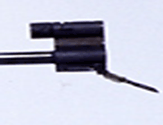
A marker at the end of the barrel that aids in aligning a shot with the target.
5. Harness
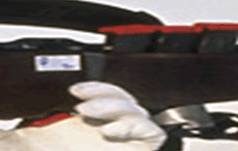
Used to carry the rifle on the athlete's back while skiing.
6. Magzine
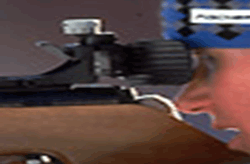
Holds clips. Each clip holds five .22-calibre rifle cartridges; up to four clips can be stored in the rifle stock while the athlete skis the course.
7. Rear Sight
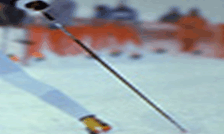
A clear cylinder that magnifies the target (to align the target correctly, the fore sight should be perfectly centred in the rear sight; generally, one eye is shut to eliminate distractions)
8. Ski Poles
Poles are generally longer and stiffer than those used for classic technique and extend to the chin or mouth of the skier; baskets and tips have the same design as classic technique poles.
9. Skis & Wax
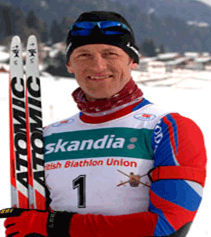
Freestyle technique skis are shorter, nominally stiffer and have tips that curve less than classic technique skis. Glide wax is applied to the entire under surface.
10. Ski Suit

Reduces wind impact and resistance.
11. Target
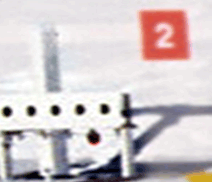
The size of the target varies according to the position (standing or prone) of the contestant. If a contestant hits a target that is coloured black, a white disc slides across it, indicating a successful shot.
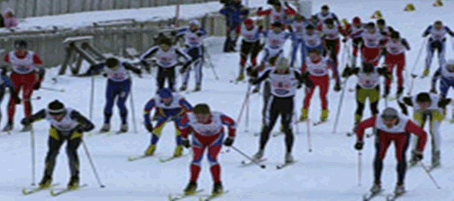
|

